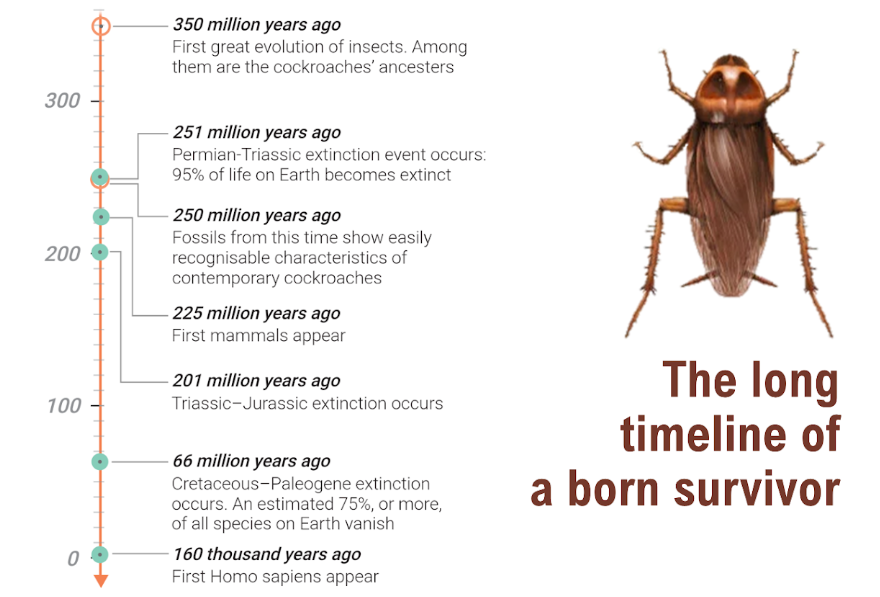Bullish? Bearish? No, I’m Cockroach-ish!
Annoying? Icky? Slimy? Dirty? Dangerous? Lovable? Stupid?
What comes to your mind when you think of a cockroach? (Cheers to you if you chose Lovable 😊)
No matter what you think of them, there is one fact about cockroaches no one can deny: They just don’t go down easy.
Just the other day, I discovered that my house still gets a newspaper subscription when I found my wife running around with a folded newspaper, trying to swat away at something I couldn’t see first. “It’s a damn cockroach!”, she screamed when I asked. “They’re so cute & harmless”, I said. The stare I got from her, was as if I said something for which I deserved to be tried in court.
And then the problem solved itself. One of my cats walked in proudly, carrying this dead 2.5 inch creature in his mouth, laying the corpse down right at my feet. Poor thing was on its back, all its hairy legs pointing straight at my ceiling. A pitiful sight.
And then, in a delightful ‘up yours’ moment, this roach suddenly twisted and turned, got on its feet and scurried away towards the couch. Before we could say “what”, it morphed into an even more terrible monster, making my wife scream again “It’s a damn flying cockroach!” And the hunt began again.
This ever happen to you? Tried to murder a cockroach, only to have the exasperating realization that it was the same cockroach you thought you’d flattened some time before! They go everywhere and seem like they can get by anything, including water, repellant sprays, pets at home, and more. I swear I think one at home survived a full washing machine run too. I was flabbergasted when I read that a cockroach can withstand up to 900 times its body weight!
Hence, one could ask the question: Are these little creatures really supernaturally resilient, surviving everything one might throw at them?
Well, you’d be quite right for thinking so.
The ancestors of modern cockroaches started their journey on this planet over 300 million years ago. This was way before the era of the dinosaurs. In fact, entire continents looked nothing like they do today. That cockroaches are still scurrying around today means that these little crawly creatures have survived multiple mass extinction events.
251 million years ago, the Permian-Triassic extinction event occurred- most plants and animals were obliterated after a series of massive volcanic eruptions in Siberia leading to massive global warming, post which 95% of life on Earth became extinct. About 50 million years later, the Triassic– Jurassic extinction occurred and wiped out all the dinosaurs. And then 66 million years ago the Cretaceous– Paleogene extinction occurred, said to be caused by the impact of a massive asteroid 10 to 15 km wide, which wiped out about 75% or more of all species on the planet at the time.
The best bit- all this was millions of years before the first Homo Sapiens appeared on Earth, about 160,000 years ago.


And our friend, the Cockroach, lived through it all.
So it’s hardly surprising that our efforts to get rid of them often come to nought. They’re extremely hardy, and will probably outlive humanity by millions of years.
6: I wish I had superpowers.
— Kate Allen Fox on hiatus (@kateallenfox) July 25, 2022
Me: That'd be fun. What kinds of powers?
6: Well, I think I'd want some cockroach DNA because then I'd be able to survive being crushed by 300-600x my weight with my thin, flexible exoskeleton.
Me: 👀
6: Plus, I could survive a week w/out my head.
This disconcerting idea might make cockroaches even more distasteful to you. But as unlikely as it might sound, it might be an excellent idea to draw inspiration from cockroaches when it comes to investing and building a solid portfolio.
In the markets, at any given point in time, you’re probably going to be ‘bullish’ or ‘bearish’. A bull market is said to be a state where most stocks and indices like Nifty, Sensex etc are on the rise, while a bear market is when they fall for a sustained period of time.


Anyway, both these kinds of investors face undesirable outcomes when the trend goes against their expectations. To ride out the highs and lows without crashing and burning, you must be prepared for effectively any eventuality at all. And perhaps have the patience, resilience and survival instinct to make it through it all. Just like cockroaches.
Let us propose our beautiful “cockroach approach” to investing.
The cockroach approach: an all-weather survival portfolio.
Let’s start with two facts about cockroaches. First, as we’ve already discussed, it takes a lot to get rid of cockroaches. They know how to survive. Even after what should’ve been a lethal blow, they seem to be able to pick themselves up, dust themselves off, and quickly move on to merrily ruining another unsuspecting victim’s day. Second, they keep compounding: through bitter experience, we humans realized a long time ago that even a single live cockroach in our homes can quickly lead to a whole army of roaches springing up.
When you think about it, both of these are simple traits we’d love for our investment portfolio. In other words, we want our portfolio to survive any extreme events the market might throw at us, while also always compounding the returns it delivers.
But before we get to how one could build such a portfolio, let’s look at the four main high-level economic contexts in which most investing activities are carried out.
The four investing environments
The investing environment, or the economic context that determines investing strategies, can be broadly said to go through four different kinds of periods (in no particular sequence). These are periods of growth, decline, inflation, and deflation. Often, stagnation.


- Growth: During a period of growth, the economy booms, and businesses see a boost in their activity and performance level. The stock market generally reacts positively in such an environment, with all major indices and stock prices showing an upward trend. Almost everyone seems to make money in these phases via equity funds, and many tend to become overconfident about their own investing abilities.
- Decline: A decline or recession in the economy is when there is a contraction of business activities and a slowdown in economic activity. This has the opposite effect on the stock market as the growth phase and is characterized by falling share prices. This is where few people (the contrarians) make money while most tend to lose it. In these times, one starts considering the benefits of debt funds or hybrid funds- seemingly better at reducing the impact of market falls.
- Inflation: During periods of inflation, there’s a general increase in price levels. Inflation is typically a broad measure, such as the overall increase in prices or the increase in the cost of living in a country. When things become expensive, the value of money falls and one may go back to holding on to savings more than earlier, trying to survive through the rising expenses.
- Deflation: In these times, the economy might contract, prices might drop and unemployment may rise for a relatively long period of time. These can be times of trouble, even with the increase in your purchasing power, and may subsequently lead to elongated times of recession, or worse, depression.
Most investors tend to focus only on stocks and bonds while building their portfolios. Sure, those are great investments, but they only help you during two of these four kinds of periods. Stocks tend to perform well during periods of growth when there is an increase in business activity, and when plenty of growth avenues are available. Similarly, bonds can your saviors during times of degrowth, when the economy is contracting and markets generally aren’t rising.
Such a simplified equity + bonds approach is sometimes held up as being a great general strategy to build wealth. But what happens when things take a sharp turn for the worse? What if there’s a high level of inflation in the economy? What if a recession sets in due to events like wars or pandemics- which is what we might be on the verge of today?
This is where being a cockroach gives you an edge. Let’s find out how.
How can one be a ‘cockroach-ish’ investor?
When building a “cockroach portfolio”, the most crucial thing to remember is that your goal is to survive. While you might not thrive in all economic scenarios with such a portfolio, you can rest assured that over time, your investing outcomes will be fruitful.
How does it feel to survive in this market 🥲🥲 pic.twitter.com/B2Y9nRUUQ2
— Luffy (@NFTLuffy) July 26, 2022
A bullish investor focuses on growth and aims to profit when the markets are rising; a bearish investor is pessimistic about market trends and takes short positions to profit from falling prices. Thus, in general, being a bull or bear tends to make most sense only during specific kinds of predictable trends, and having such an opinionated approach might lose your money if the market makes some unexpected moves. Because as we all know…


A cockroach-ish investor, on the other hand, optimizes their portfolio keeping all the four possible investing environments in mind.
Okay, how can you build a cockroach portfolio?
Like all other market players, cockroach-ish investors also focus on stocks during phases of growth, and on bonds during deflationary periods.
However, they bolster their portfolios by investing in other asset classes as well.
For instance, gold is considered to be a relatively safe investment vehicle when it comes to combating the effects of inflation. Gold prices tend to shoot up when general price levels increase and uncertainty rises. Gold will thus help keep a cockroach portfolio balanced. The yellow metal can also be held in the form of bullion or jewelry, but doing so comes with storage costs and security risks. To put yourself in a better position, you can hold some portion of your gold investment in the form of gold bonds, which are highly liquid and do not involve storage or safety risks. Or the new age option, Gold-based Exchange Traded Funds (ETFs).
And in a recession, it’s cash that keeps you going, it sort of keeps you safe. A cockroach-ish investor may choose to hold cash in their savings account, or perhaps even in the form of hard cash (if you know where to hide it & keep it safe, that is).
What's the crypto equivalent of the "cockroach portfolio"?https://t.co/uU007KXgss pic.twitter.com/RiLYGyadjC
— Defi Dividends (@DefiDividends) February 16, 2022
A cockroach portfolio's total value can simply be split up equally among the four categories discussed above: Equities, Bonds, Gold & Cash. Yes, it is literally that simple.
Moreover, as a cockroach-ish investor for whom survival means everything, you can further diversify the investments you make for each environment. For instance, you can pick up stocks of companies operating in different sectors that are not highly correlated, say IT and mining. Or equity mutual funds that invest in different sectors. The logic being, even if mining stocks see a decline, the IT sector is likely to remain unscathed. And then not everything should be invested in India. Diversify further by investing in the US or other global markets like China.
Similarly, you can also hold different kinds of bonds, such as corporate or government bonds. While corporate bonds could give good returns but at a certain risk, government bonds are almost risk-free. Hence, having a mix of both in your portfolio is a good strategy. Again, the easy way to do this is via debt mutual funds.
A cockroach portfolio is supposed to safeguard your returns regardless of the state of the economy, but how likely is it to actually perform well? Let’s try to figure that out by looking at what the markets have taught investors over decades.
Why should a cockroach portfolio hold up well?
Six syllables, one word: Di. Ver. Si. Fi. Ca. Tion.
Statistically, these four asset classes — stocks, bonds, gold, and cash — are only loosely correlated. A change in the value of one tends to not have a major influence on the values of the others in the same direction. As a result, diversifying your portfolio in this manner should make it stronger. In addition, further diversification within each of these asset classes should make your portfolio resistant to any major sector-specific turbulence in the market, and can serve as an additional hedging strategy.
While such a portfolio might not come across as being the most intelligent or ‘the best’ in terms of the returns you’ll earn, it probably is much safer than most conventional portfolios and will help you survive for long. For instance, imagine how such a portfolio would have fared during the Covid-19 pandemic when the world witnessed one of the biggest sell-offs in history. Better than yours, I would postulate.
During that phase, markets across the world crashed and saw new lows every day. At the same time, with uncertainty rising, gold prices soared as investors moved toward this safer asset. Thus, as one component of the cockroach portfolio dropped in value, another gained in value, reducing the overall impact of the market crash.
You never know which way the market will move next. If you adopt a cockroach-ish approach, this shouldn’t bother you at all. While the returns of more conventional portfolios might be better than those of yours at times, you’ll have something invaluable that others won’t: potential invincibility.
Go forth and scurry the markets!
Learning about how cockroaches have managed to survive an endless series of cataclysmic events over hundreds of millions of years can inspire us to take a novel and powerful approach to investing. While a majority of market players categorize themselves as being either bullish or bearish (and might perform well when the market goes their way), you can remain unflappable through all the inevitable turbulence simply by emulating the humble cockroach.
As I close, I am reminded of that phoenix-like-flying-cockroach my cat hunted down for me the other day, but also of the following quote by English naturalist, geologist and evolutionary biologist Charles Darwin.


So, are you still going to be just bullish or bearish?
Or are you ready to be Cockroach-ish?
Note from the author: This post is inspired by this brilliant article I read recently. I highly recommend you read it too.
About the author
The Rational Ghost. This is one rational storyteller that provides interesting insights & stories about investing and tries to be completely unemotional about it. Lives in the shadows, doesn’t want anyone to know its real name.Disclaimer
This note is for information purposes only. In this material DSP Asset Managers Pvt Ltd (the AMC) has used information that is publicly available and is believed to be from reliable sources. While utmost care has been exercised, the author or the AMC does not warrant the completeness or accuracy of the information and disclaims all liabilities, losses and damages arising out of the use of this information. Readers, before acting on any information herein should make their own investigation & seek appropriate professional advice. Any sector(s)/ stock(s)/ issuer(s) mentioned do not constitute any recommendation and the AMC may or may not have any future position in these. All opinions/ figures/ charts/ graphs are as on date of publishing (or as at mentioned date) and are subject to change without notice. Any logos used may be trademarks™ or registered® trademarks of their respective holders, our usage does not imply any affiliation with or endorsement by them.
Past performance may or may not be sustained in the future and should not be used as a basis for comparison with other investments.
Mutual fund investments are subject to market risks, read all scheme related documents carefully.







Leave a comment